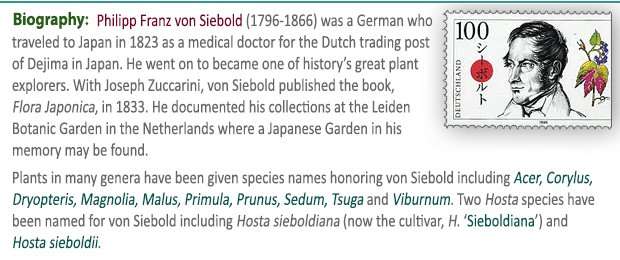|
 The name on the label
above is misspelled. The name on the label
above is misspelled.
  This
H. sieboldii-type cultivar of
unidentified parentage is from
Japan and was registered by
Peter Ruh of Ohio in 2005
and
re-registered
with new data in 2018. It forms a
medium size (15 inches high by 24 inches wide) mound of lanceolate, moderately
wavy leaves that are slightly shiny on top and very shiny on the bottom. Purple,
striped flowers bloom on scapes 28 to 34 inches tall from August into September
but do not set seed. This
H. sieboldii-type cultivar of
unidentified parentage is from
Japan and was registered by
Peter Ruh of Ohio in 2005
and
re-registered
with new data in 2018. It forms a
medium size (15 inches high by 24 inches wide) mound of lanceolate, moderately
wavy leaves that are slightly shiny on top and very shiny on the bottom. Purple,
striped flowers bloom on scapes 28 to 34 inches tall from August into September
but do not set seed. The registration materials
state: "...unusual color, different from 'Kisugi', larger with purple
anthers..."
 According to
The Hostapedia by Mark Zilis (2009), "...virtually identical to 'Kisuji',
however, has yellow anthers...'Inaho' is reported to have purple
anthers." According to
The Hostapedia by Mark Zilis (2009), "...virtually identical to 'Kisuji',
however, has yellow anthers...'Inaho' is reported to have purple
anthers."
 "Inaho
Gibōshi, the "golden wave of rice hosta." Inaho means "ear of rice,"
the name picturing the yellow- and green-striped vista of a maturing field of
rice. Similar to H. sieboldii 'Mediopicta' but sterile and provisionally
linked with H. 'Lancifolia'." "Inaho
Gibōshi, the "golden wave of rice hosta." Inaho means "ear of rice,"
the name picturing the yellow- and green-striped vista of a maturing field of
rice. Similar to H. sieboldii 'Mediopicta' but sterile and provisionally
linked with H. 'Lancifolia'."
Mikiko Lockwood in an article on The Hosta Library titled,
A Little About Japanese Hosta Terms defines the term ki
as yellow or gold and the term suji as streak or line.


 |



